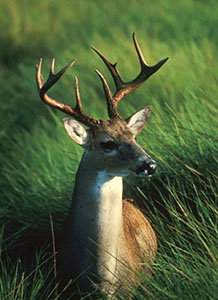Preventing Deer from Becoming Pests
 |
|
White-tailed deer have increased fifteen-fold since the 1990s in eastern North America. Photo: USDA Forest Service, Southern Research Station, Bugwood.org. |
Deer eat gardens. Spread Lyme disease. Collide with cars, threaten human lives. Native generalist white-tailed deer have increased fifteen-fold since the 1990s in eastern North America.
Experts are using IPM techniques to prevent deer from destroying ecosystems, disrupting habitat enough to put wild birds at risk, and boosting the presence of invasive plants that move into voids left by excessive grazing. For example, ecologists are trying to figure out how the presence of too many deer in an area might affect the balance of native and introduced plants. Meanwhile, other researchers are making attempts to control deer numbers, with interesting results.
New research shows that even when deer prefer to eat a plant, rather than reducing its numbers, they might spread it more widely through their feces. Also, deer don’t particularly care whether a plant is native or introduced (or invasive). Deer avoid certain invasive plants that are increasing in abundance, and attack some native plants.
Deer Eat What's in Season and Available
Kristine Averill, a research associate in Cornell University’s Soil and Crop Sciences Section, led research on the topic as a graduate student in ecology at Penn State. Her results were recently published in the journal Biological Invasions.
Averill and her team tested herbivore preference for common plants in the Eastern US, categorized by native or introduced status, and by species.
They conducted the study at the 22-acre Pennsylvania State University Deer Research Center in State College, where a captive population of 75-100 deer resides in nine pens ranging in size from 0.3 to 3.5 acres.
Deer were offered a choice of fifteen plant species; researchers replicated fifteen trials in spring, summer, and autumn.
"Deer really do seem to avoid eating garlic mustard, Japanese stiltgrass, and barberry," Averill said. "While this appeared to be the case based on field work, we showed the same pattern in a controlled setting. Deer avoidance of these species helps explain why they are so invasive in forest understories."
Sterilize or Hunt Them?
As reported in a Washington Post article by Jackson Landers, Cornell University made an attempt to reduce deer populations through a sterilization program, with interesting results.
Cornell had considered culling deer through hunting, but in 2009 began a sterilization program.
What they hadn't counted on: Bucks can travel for miles in search of does in heat. They would need to target a large number of does for sterilization.
At a cost of roughly $1200 per deer, 77 does were captured and sterilized through tubal ligation. (Costs would have been higher without the help of the Cornell University College of Veterinary Medicine.)
Yet the total number of deer remained steady over five years.
Population numbers were offset by increases in buck numbers. There were about 100 deer on campus when the program started, and there were still about 100 deer five years later.
The program had inadvertently created a population of buck magnets that drew in new deer from the surrounding area.
"I'm an ecologist looking at the literature," Bernd Blossey, chair of the Cornell Deer Research and Management Committee, said in the Washington Post. "I thought that sterilization in an open population where things can move in and out won't work. Maybe it was worth doing it in a sophisticated way to say we tried in the best possible way and it didn’t make a difference."
The tubal ligation program was halted, replaced by a combination of professional trapping and volunteer archers. After nuisance deer removal in 2014, cameras estimated about 58 deer on campus.
The sometimes controversial issue of what to do about deer simmers on, and occasionally boils over. Meanwhile, ecologists are using IPM techniques to study deer behavior and feeding preferences, in hopes of protecting nature and preventing deer from spreading Lyme disease, colliding with cars, or turning your garden, suburban landscape, or nature preserve into a wasteland.
For further reading
Landers, J. Trying to limit the number of deer, with surprising results. September 29, 2014. Washington Post.
Averill, K., et al. (2016). Deer feeding selectivity for invasive plants. Biol Invasions (2016) 18:1247–1263 DOI 10.1007/s10530-016-1063-z
— by CHRIS GONZALES
The Northeastern IPM Center promotes integrated pest management for reducing risks to human health and the environment. If republishing our news, please acknowledge the source (“From Northeast IPM Insights”) along with a link to our website.
